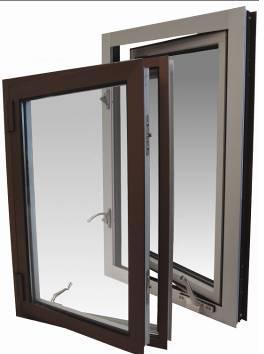ASHRAE 90.1 "Energy Standards for Buildings Other Than Low-Rise Residential Buildings," and the commercial requirements of the International Code Council's "International Energy Conservation Code (IECC)" are updated in each three-year code cycle, to reflect the need for more energy-efficient and environmentally-responsible building envelopes. Under prescriptive compliance options within these codes, minimum performance requirements are mandated for a number of important parameters, including Window-to-Wall Ratio (WWR), Solar Heat Gain Coefficient (SHGC), air infiltration rate, and of course, U-Factor.
U-Factor (also called U-Value) is a measure of thermal transmittance; air-to-air heat flow per unit time, area and temperature drop. U-Factor is the reciprocal of the familiar "R-Value" cited for insulation products. With U-Factor, "...the smaller, the better."
NFRC Labels
U-Factor is determined using guarded hot box testing and finite element thermal modeling standards of the National Fenestration Ratings Council (NFRC). NFRC labeling is a compliance option for most state and local codes.
Almost all of Wausau's window products are listed in the NFRC Certified Products Directory. Wausau design engineers are certified as Approved Calculation Entities (ACEs) for NFRC's new Component Modeling Approach (CMA), addressing curtainwall and window wall for
non-residential applications.
Standard Test Size
Because of the residential origination of the NFRC organization, NFRC operable window test sizes are based on small, residential windows. An example of the "size effect" in a high-performance, thermal barrier, aluminum casement window is shown below.
These small, residential sizes apply to operable windows only; hence, NFRC U-Factors of fixed windows, window wall and curtainwall are realistic for non-residential and commercial applications.
Misleading Claims
Misinformation commonly cites center-of-glass U-Factors, instead of the overall window U-Factor required by codes, which includes frame and edge-of-glass areas. Test size is critical in assessing overall window U-Factor validity. Remember, spandrel areas don't "count" in determining NFRC U-Factor, only vision glass and adjacent framing.
Other misleading U-Factor claims are based on residential glass thickness. While the use of 1/8" (3mm) glass incrementally can improve U-Factor, it is usually unacceptable to Wausau's architectural clients, due to roller wave, pillowing, limited coating/color options, and breakage during installation.
The limitations and warranty concerns of IGUs incorporating suspended films are even more restrictive.
Like glass thickness, unsightly residential IG spacer systems are often the basis of misleading U-Factor claims. Many of these spacer systems cannot be structural silicone glazed or used on large lites. Stainless steel, warm-edge spacers - while marginally lower in thermal performance than non-metallic spacers - are a better choice, since they are similar in breadth of application and warranty to conventional, mill finish, aluminum spacers.
Some manufacturers even turn windows "inside out," with removable glazing beads placed to the exterior, to make U-Factors look better.
Triple Insulating Glass
U-Factors are reduced significantly by using triple-insulating glass, with corresponding improvements in condensation resistance. Thermal performance of the new Wausau INventTM 2250i-XLT Series is summarized in the following table:
|
Triple IG
Thermal Performance
|
NFRC U-Factor
BTU/hr-ft2-°F
|
SHGC
Range
|
AAMA U-Factor
BTU/hr-ft2-°F
|
CRF
|
|
Tested
|
Modeled Range
|
Tested
|
|
2250i-XLT
Fixed
|
0.19
|
0.21 to 0.26
|
0.26 to 0.32
|
0.20
|
68 Frame
80 Glass
|
|
2250i-XLT
Awning or Project-Out Casement
|
0.33
|
0.33 to 0.38
|
0.21 to 0.25
|
0.33
|
64 Frame
77 Glass
|
|
2250i-XLT Hopper or Project-In Casement
|
0.34
|
0.33 to 0.38
|
0.20 to 0.25
|
0.35
|
62Frame
77 Glass
|
|
Unless noted, tested performance data listed is based on triple insulating glass with spectrally-selective Low-E coatings on surfaces #2 and #4, two ½" Argon gas fills, and warm edge spacers. Modeled NFRC performance data range listed is based on various, clear substrate glass configurations, with validation test per NFRC requirements. Contact Wausau for project-specific, thermal-performance modeling. Unless specifically noted, results do not apply to dual- or triple-glazed products with between-glass blinds. Contact Wausau for test data on these products.
|
Wausau's standard, projected window hardware packages are designed to "carry" triple insulating glass, as triple glazing incorporating between-glass blinds has long been an optional upgrade for our hospital and school window designs.
Balanced Design
No discussion of fenestration U-Factors would be complete without emphasizing the importance of balanced design. U-Factor is just one aspect of overall energy performance - air infiltration, SHGC, Visible Light Transmittance (VT), durability, and CRF also must be optimized.
Even in cold climates, commercial buildings are usually cooling-mode dominated, and lower U-Factors can be relatively unimportant in overall energy consumption. Also, keep in mind that the second decimal point makes little substantive difference in performance, and due to testing and modeling accuracy, small differences in U-Factor should not be used to differentiate products.
|